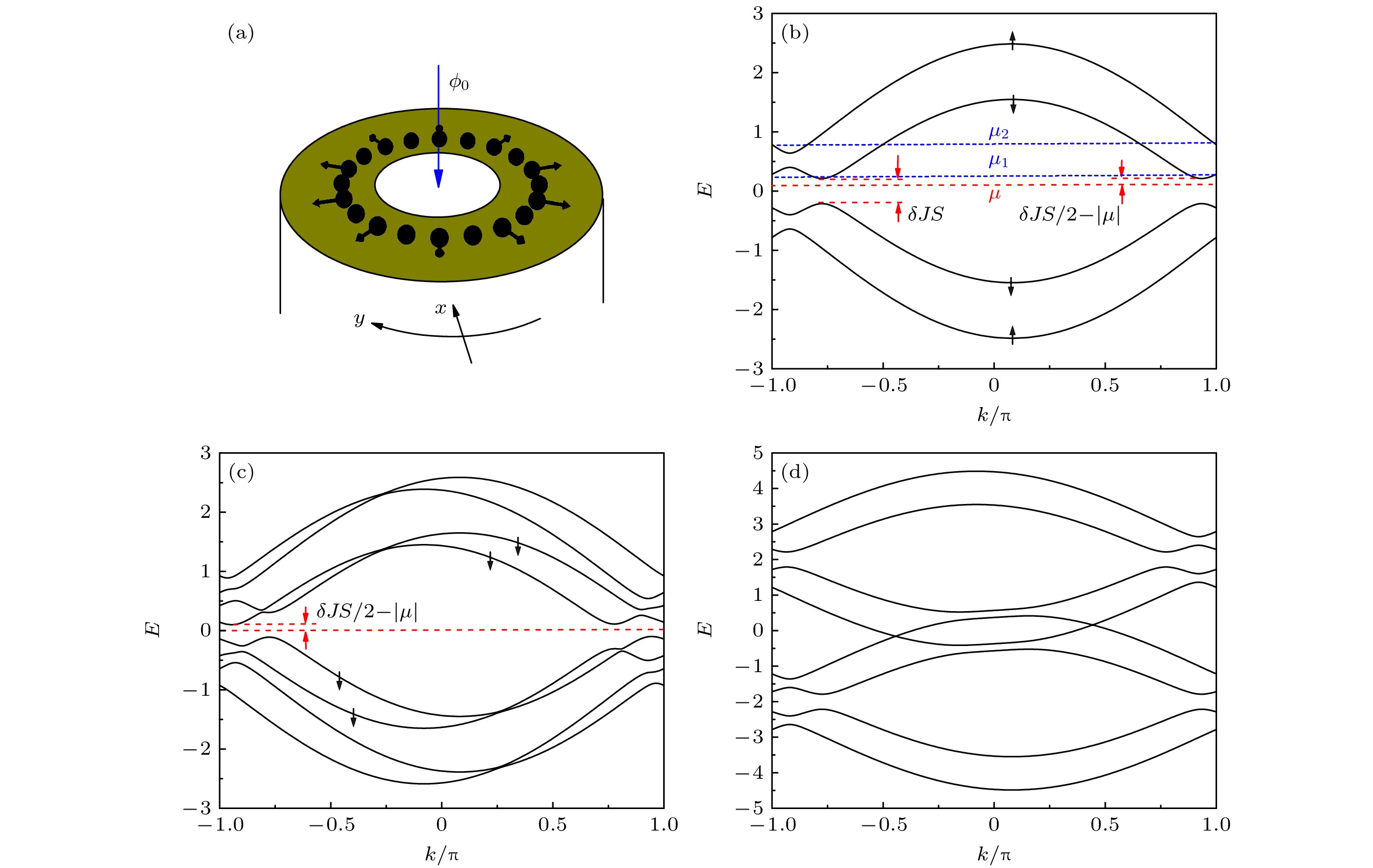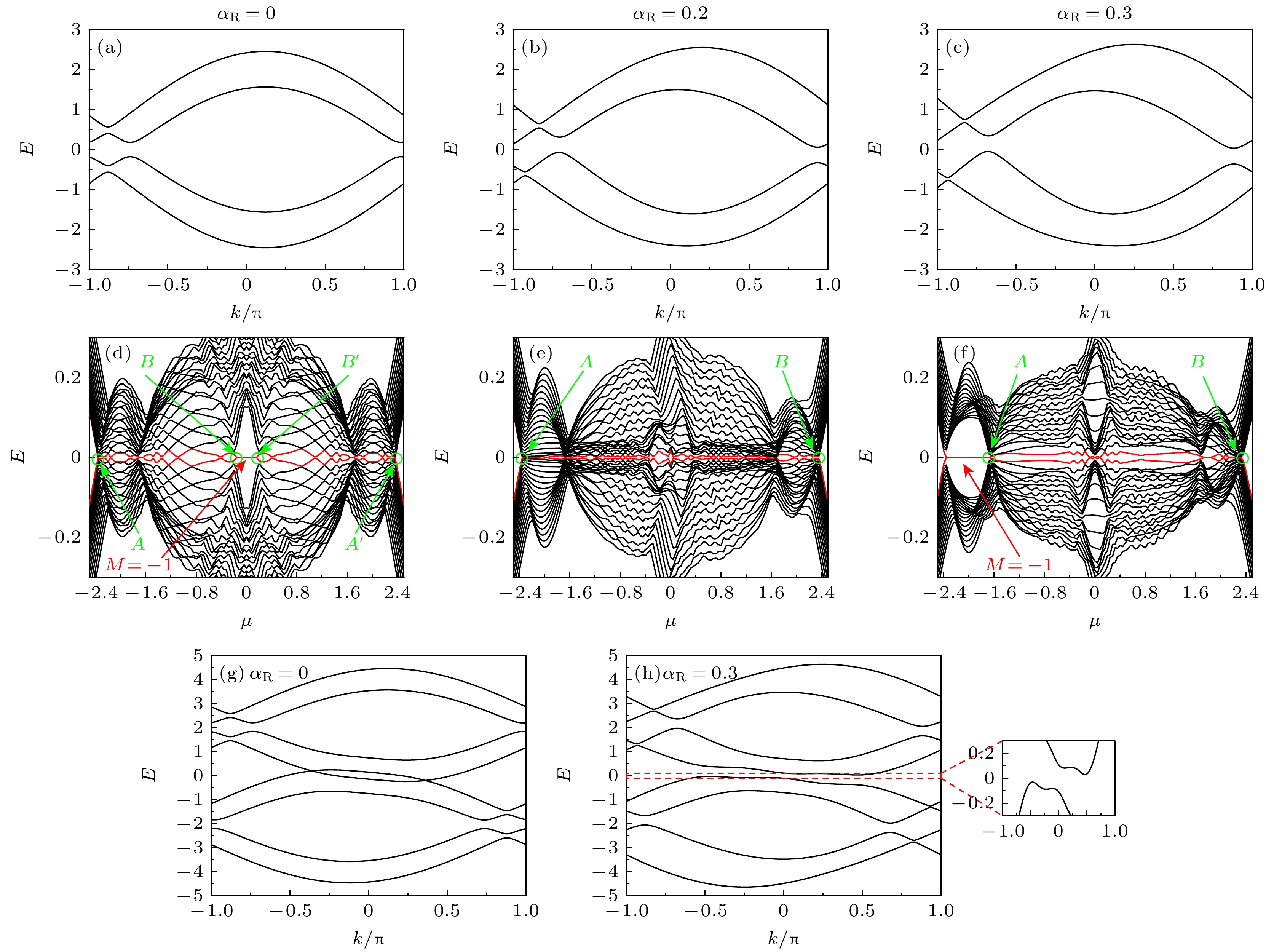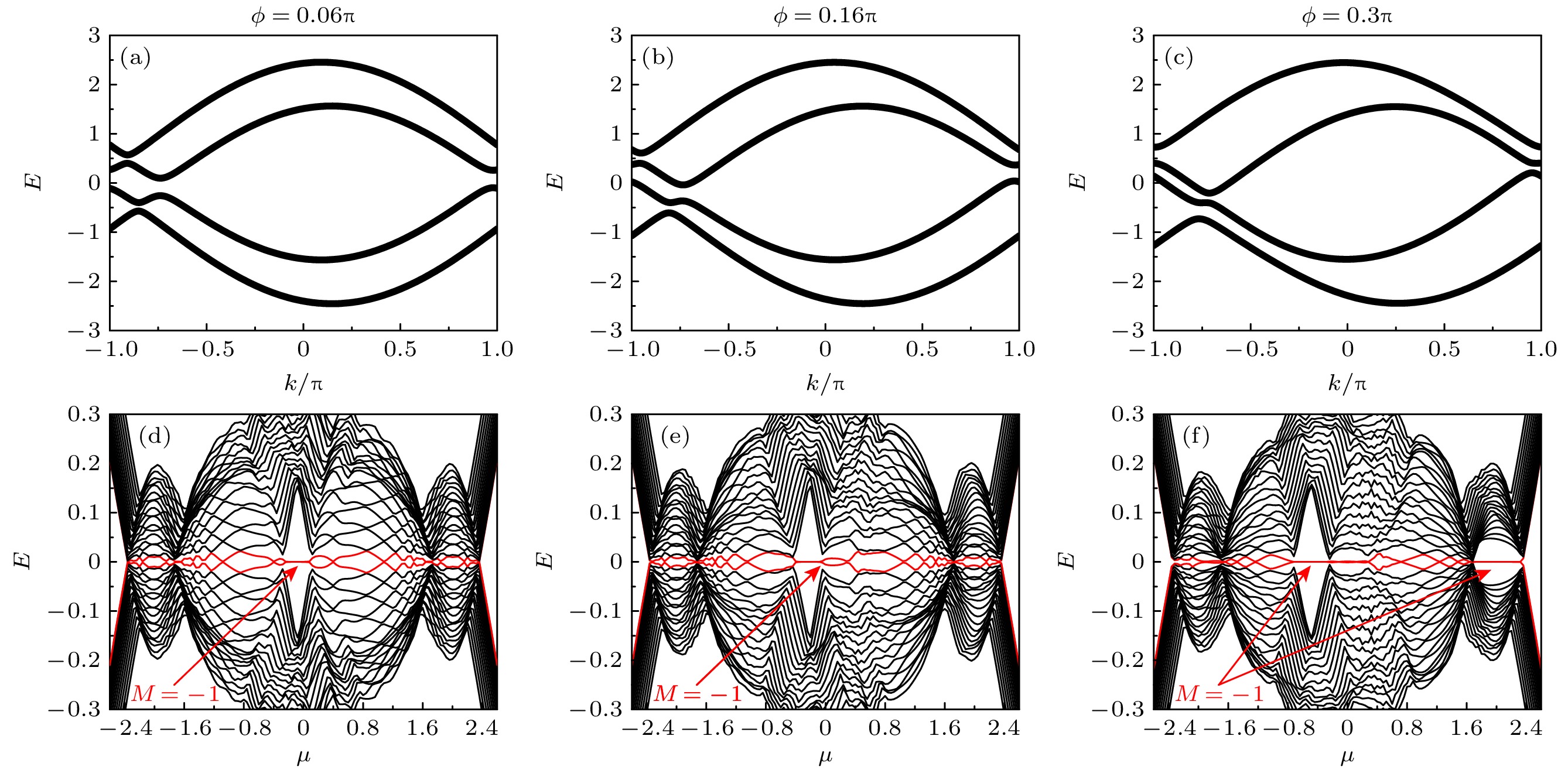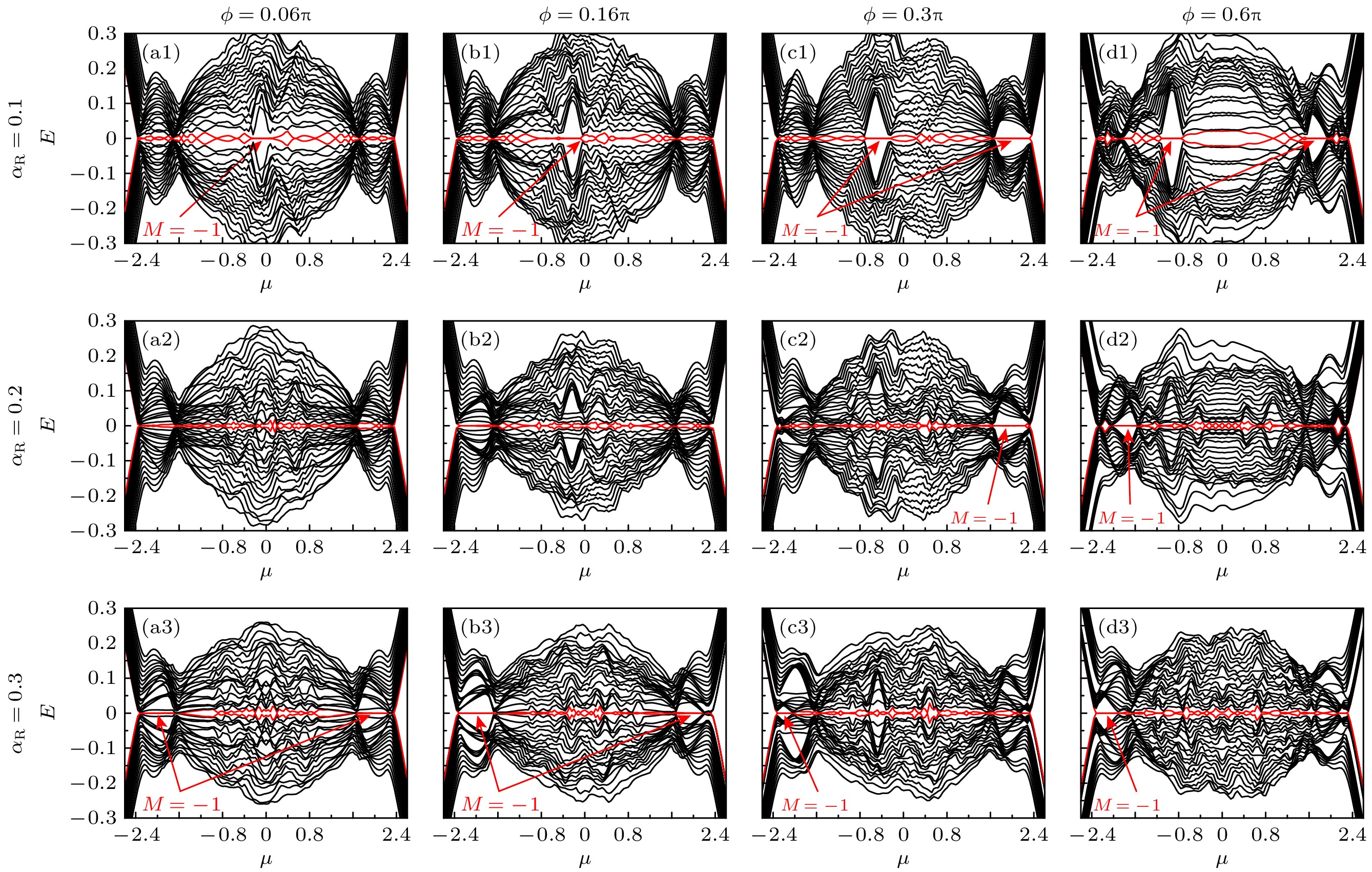-
A magnetic flux threading through magnetic atomic rings can induce topological superconductivity. It provides a novel approach to achieving low-dimensional (2D) topological superconductivity, which requires neither spin-orbit coupling nor helical magnetic order. In this paper, we introduce a topological superconductor model by depositing a ferromagnetic atomic ring on the surface of a 2D s-wave superconductor. When the moments of the magnetic atoms are perpendicular to the external magnetic field, a magnetic flux can induce topological superconductivity. Considering practical experiments, because the magnetic atomic chain breaks the inversion symmetry of the surface of the 2D substrate, the Rashba spin-orbit coupling (SOC) is introduced, leading to the appearance of helical magnetic order in the atomic chain. According to previous researches, this helical magnetic order ensures that the magnetic moments of the ring are perpendicular to the external magnetic field, and the patch angle of neighbor moment of the helical order is proportional to the strength of the SOC. However, the helical order or Rashba SOC may introduce topological superconductivity on their own. It is meaningful to investigate the influence of the effects of the Rashba SOC and helical magnetic order on the flux induced topological superconducting states. We find that the Rashba SOC has a disruptive effect on the existing topological state, while helical magnetic order merely shifts its transition position in the parameter space. Therefore, when selecting materials for experiment, it is recommended to choose materials with lower Rashba SOC strength.
[1] Nadj-Perge S, Drozdov I K, Li J, Chen H, Jeon S, Seo J, MacDonald A H, Bernevig B A, Yazdani A 2014 Science 346 602
 Google Scholar
Google Scholar
[2] Li J, Chen H, Drozdov I K, Yazdani A, Bernevig B A, MacDonald A H 2014 Phys. Rev. B 90 235433
 Google Scholar
Google Scholar
[3] Sau J D, Brydon P M R 2015 Phys. Rev. Lett. 115 127003
 Google Scholar
Google Scholar
[4] Heimes A, Mendler D, Kotetes P 2015 New J. Phys. 17 23023
[5] Brydon P M R, Das Sarma S, Hui H, Sau J D 2015 Phys. Rev. B 91 064505
 Google Scholar
Google Scholar
[6] Kim H, Palacio-Morales A, Posske T, Rózsa L, Palotás K, Szunyogh L, Thorwart M, Wiesendanger R 2018 Sci. Adv. 4 eaar5251
 Google Scholar
Google Scholar
[7] Schneider L, Beck P, Posske T, Crawford D, Mascot E, Rachel S, Wiesendanger R, Wiebe J 2021 Nat. Phys. 17 943
 Google Scholar
Google Scholar
[8] Schneider L, Beck P, Rózsa L, Posske T, Wiebe J, Wiesendanger R 2023 Nat. Commun. 14 2742
 Google Scholar
Google Scholar
[9] Choy T P, Edge J M, Akhmerov A R, Beenakker C W J 2011 Phys. Rev. B 84 195442
 Google Scholar
Google Scholar
[10] Martin I, Morpurgo A F 2012 Phys. Rev. B 85 144505
 Google Scholar
Google Scholar
[11] Braunecker B, Simon P 2013 Phys. Rev. Lett. 111 147202
 Google Scholar
Google Scholar
[12] Pientka F, Glazman L I, von Oppen F 2013 Phys. Rev. B 88 155420
 Google Scholar
Google Scholar
[13] Klinovaja J, Stano P, Yazdani A, Loss D 2013 Phys. Rev. Lett. 111 186805
 Google Scholar
Google Scholar
[14] Vazifeh M M, Franz M 2013 Phys. Rev. Lett. 111 206802
 Google Scholar
Google Scholar
[15] Nadj-Perge S, Drozdov I K, Bernevig B A, Yazdani A 2013 Phys. Rev. B 88 020407
 Google Scholar
Google Scholar
[16] Pöyhönen K, Westström A, Röntynen J, Ojanen T 2014 Phys. Rev. B 89 115109
 Google Scholar
Google Scholar
[17] Kim Y, Cheng M, Bauer B, Lutchyn R M, Das Sarma S 2014 Phys. Rev. B 90 060401(R
 Google Scholar
Google Scholar
[18] Reis I, Marchand D J J, Franz M 2014 Phys. Rev. B 90 085124
 Google Scholar
Google Scholar
[19] Westström A, Pöyhönen K, Ojanen T 2015 Phys. Rev. B 91 064502
 Google Scholar
Google Scholar
[20] Xiao J P, An J 2015 New J. Phys. 17 113034
 Google Scholar
Google Scholar
[21] Pawlak R, Kisiel M, Klinovaja J, Meier T, Kawai S, Glatzel T, Loss D, Meyer E 2016 npj Quantum Inf. 2 16035
 Google Scholar
Google Scholar
[22] Hess R, Legg H F, Loss D, Klinovaja J 2022 Phys. Rev. B 106 104503
 Google Scholar
Google Scholar
[23] Röntynen J, Ojanen T 2014 Phys. Rev. B 90 180503
 Google Scholar
Google Scholar
[24] Schneider L, Brinker S, Steinbrecher M, Hermenau J, Posske T, Dias M D S, Lounis S, Wiesendanger R, Wiebe J 2020 Nat. Commun. 11 4707
 Google Scholar
Google Scholar
[25] Xiao J P, Hu Q, Luo X B 2024 Phys. Rev. B 109 205420
 Google Scholar
Google Scholar
[26] Li J, Neupert T, Bernevig B A, Yazdani A 2016 Nat. Commun. 7 10395
 Google Scholar
Google Scholar
[27] Kitaev A Y 2001 Phys. Usp. 44 131
 Google Scholar
Google Scholar
[28] Schnyder A P, Ryu S, Furusaki A, Ludwig A W W 2008 Phys. Rev. B 78 195125
 Google Scholar
Google Scholar
[29] Ryu S, Schnyder A P, Furusaki A, Ludwig A W W 2010 New J. Phys. 12 065010
 Google Scholar
Google Scholar
-
图 1 (a)磁性原子以铁磁序次近邻沉积在空心圆筒s波超导表面的示意图; (b)不引入超导时正常态磁性原子链能带. (c), (d)引入超导配对后的能带, $ V=0.4, \;JS=0.5,\; \varDelta =0.1,\; \phi =0.04{\mathrm{\pi }} $, 黑色箭头表示自旋 (c)当化学势落于能隙$ \delta JS $之间时, 超导态有能隙, $ \mu =0.1 $; (d)图化学势落于$ \delta JS $以外, 超导态无能隙, $ \mu =-2 $
Fig. 1. (a) Schematic of magnetic atoms deposited in a ferromagnetic order as next-nearest neighbors on the surface of an s-wave superconductor on the surface of a hollow cylindrical s-wave superconductor; (b) the band structure of the normal state of the ring. (c), (d) The band structures of the superconducting states with $ V=0.4,\; JS=0.5,\; \varDelta =0.1,\; \phi =0.04{\mathrm{\pi }}, $ the black arrows represent spin up or dowm: (c) When the chemical potential falls between the energy gap $ \delta JS $ in the normal state, the superconducting state is gapped, $ \mu =0.1 $; (d) the superconducting state is gapless when the chemical potential falls outside the energy gap $ \delta JS $ in the normal state, $ \mu =-2 $.
图 2 $ JS=0.5,\; \mu =0.1,\; \phi =0.04{\mathrm{\pi }} $ (a)铁磁链模型(1)的开边界能谱图, 包含了200个子格, $ V=0.4 $; (b)此模型的拓扑相图,
Fig. 2. $ JS=0.5,\; \mu =0.1, \;\phi =0.04{\mathrm{\pi }}: $(a) The energy spectrum of the ferromagnetic ring model (1) on the condition of open boundaries with 200 sites, $ V=0.4 $; (b) the topological phase diagram.
图 3 铁磁链在不同自旋轨道耦合强度$ {\alpha }_{{\mathrm{R}}} $下的能带图和开边界能谱图, $ JS=0.4,\; \phi =0.06{\mathrm{\pi }},\; V=0.4, \;\varDelta =0.3 $, 开边界链长100个格子 (a)—(c)正常态能带; (d)—(f)开边界扫描化学势的能谱图, 其参数与(a)—(c)分别对应, $ A-B $和$ {A}'-{B}' $之间无能隙, $ M $是$ {Z}_{2} $拓扑数, $ - $1代表拓扑非平庸; (g), (h) $ {\alpha }_{{\mathrm{R}}}=0 $和$ {\alpha }_{{\mathrm{R}}}=0.3 $的超导能带图, 化学势为$ \mu =-2 $, (h)中小图放大了能隙附近的能带, 便于观察能隙
Fig. 3. The band structures and open boundary energy spectrums of the ferromagnetic ring with different strengths of SOC $ {\alpha }_{{\mathrm{R}}, }\;JS=0.4, \;\phi =0.06{\mathrm{\pi }},\;V=0.4,\; \varDelta =0.3 $, the open boundary ring contains 100 sites: (a)–(c) The normal state energy bands; (d)–(f) the open boundary energy spectra by scanning the chemical potential, with the parameters corresponding to (a)–(c) respectively, $ A-B $ and $ {A}'-{B}' $ are gapless. $ M $ is $ {Z}_{2} $ invariant while $ -1 $ indicates topologically nontrivial; (g), (h) the superconducting energy bands with $ \mu =-2 $ when $ {\alpha }_{{\mathrm{R}}}=0 $ and $ {\alpha }_{{\mathrm{R}}}=0.3 $, respectively, the inset in (h) shows the band structure near the gap near zero energy.
图 4 不同螺旋角下的磁性原子链能带图和开边界能谱图, $ JS=0.4, \;\phi =0.06{\mathrm{\pi }}, \;V=0.4 $. 开边界原子链包含100个格子 (a)—(c)正常态能带; (d)—(f)开边界扫描化学势的能谱图, 其参数与(a)—(c)分别对应, 超导配对强度为$ \varDelta =0.3 $
Fig. 4. The band structures and open boundary energy spectra of the magnetic ring with different patch angles, $ JS=0.4, $$ \phi =0.06{\mathrm{\pi }},\;V=0.4, $ the open boundary ring contains 100 sites: (a)–(c) The bands of the normal states; (d)–(f) the open boundary energy spectrums by scanning the chemical potential, with $ \varDelta =0.3 $.
图 5 不同螺旋角和自旋轨道耦合强度下的100个磁性原子链开边界能谱图. 图中磁性原子链包含100个格子, 其中超导配对强度为$ \varDelta =0.3 $, $ JS=V=0.4,\; \phi =0.06{\mathrm{\pi }} $
Fig. 5. The open boundary energy spectrums of the magnetic atomic ring with different strengths of SOC and patch angles. The ring contains 100 sites and $ \varDelta =0.3 $, $ JS=V=0.4,\; \phi =0.06{\mathrm{\pi }} $.
-
[1] Nadj-Perge S, Drozdov I K, Li J, Chen H, Jeon S, Seo J, MacDonald A H, Bernevig B A, Yazdani A 2014 Science 346 602
 Google Scholar
Google Scholar
[2] Li J, Chen H, Drozdov I K, Yazdani A, Bernevig B A, MacDonald A H 2014 Phys. Rev. B 90 235433
 Google Scholar
Google Scholar
[3] Sau J D, Brydon P M R 2015 Phys. Rev. Lett. 115 127003
 Google Scholar
Google Scholar
[4] Heimes A, Mendler D, Kotetes P 2015 New J. Phys. 17 23023
[5] Brydon P M R, Das Sarma S, Hui H, Sau J D 2015 Phys. Rev. B 91 064505
 Google Scholar
Google Scholar
[6] Kim H, Palacio-Morales A, Posske T, Rózsa L, Palotás K, Szunyogh L, Thorwart M, Wiesendanger R 2018 Sci. Adv. 4 eaar5251
 Google Scholar
Google Scholar
[7] Schneider L, Beck P, Posske T, Crawford D, Mascot E, Rachel S, Wiesendanger R, Wiebe J 2021 Nat. Phys. 17 943
 Google Scholar
Google Scholar
[8] Schneider L, Beck P, Rózsa L, Posske T, Wiebe J, Wiesendanger R 2023 Nat. Commun. 14 2742
 Google Scholar
Google Scholar
[9] Choy T P, Edge J M, Akhmerov A R, Beenakker C W J 2011 Phys. Rev. B 84 195442
 Google Scholar
Google Scholar
[10] Martin I, Morpurgo A F 2012 Phys. Rev. B 85 144505
 Google Scholar
Google Scholar
[11] Braunecker B, Simon P 2013 Phys. Rev. Lett. 111 147202
 Google Scholar
Google Scholar
[12] Pientka F, Glazman L I, von Oppen F 2013 Phys. Rev. B 88 155420
 Google Scholar
Google Scholar
[13] Klinovaja J, Stano P, Yazdani A, Loss D 2013 Phys. Rev. Lett. 111 186805
 Google Scholar
Google Scholar
[14] Vazifeh M M, Franz M 2013 Phys. Rev. Lett. 111 206802
 Google Scholar
Google Scholar
[15] Nadj-Perge S, Drozdov I K, Bernevig B A, Yazdani A 2013 Phys. Rev. B 88 020407
 Google Scholar
Google Scholar
[16] Pöyhönen K, Westström A, Röntynen J, Ojanen T 2014 Phys. Rev. B 89 115109
 Google Scholar
Google Scholar
[17] Kim Y, Cheng M, Bauer B, Lutchyn R M, Das Sarma S 2014 Phys. Rev. B 90 060401(R
 Google Scholar
Google Scholar
[18] Reis I, Marchand D J J, Franz M 2014 Phys. Rev. B 90 085124
 Google Scholar
Google Scholar
[19] Westström A, Pöyhönen K, Ojanen T 2015 Phys. Rev. B 91 064502
 Google Scholar
Google Scholar
[20] Xiao J P, An J 2015 New J. Phys. 17 113034
 Google Scholar
Google Scholar
[21] Pawlak R, Kisiel M, Klinovaja J, Meier T, Kawai S, Glatzel T, Loss D, Meyer E 2016 npj Quantum Inf. 2 16035
 Google Scholar
Google Scholar
[22] Hess R, Legg H F, Loss D, Klinovaja J 2022 Phys. Rev. B 106 104503
 Google Scholar
Google Scholar
[23] Röntynen J, Ojanen T 2014 Phys. Rev. B 90 180503
 Google Scholar
Google Scholar
[24] Schneider L, Brinker S, Steinbrecher M, Hermenau J, Posske T, Dias M D S, Lounis S, Wiesendanger R, Wiebe J 2020 Nat. Commun. 11 4707
 Google Scholar
Google Scholar
[25] Xiao J P, Hu Q, Luo X B 2024 Phys. Rev. B 109 205420
 Google Scholar
Google Scholar
[26] Li J, Neupert T, Bernevig B A, Yazdani A 2016 Nat. Commun. 7 10395
 Google Scholar
Google Scholar
[27] Kitaev A Y 2001 Phys. Usp. 44 131
 Google Scholar
Google Scholar
[28] Schnyder A P, Ryu S, Furusaki A, Ludwig A W W 2008 Phys. Rev. B 78 195125
 Google Scholar
Google Scholar
[29] Ryu S, Schnyder A P, Furusaki A, Ludwig A W W 2010 New J. Phys. 12 065010
 Google Scholar
Google Scholar
计量
- 文章访问数: 3287
- PDF下载量: 90
- 被引次数: 0















 下载:
下载:




